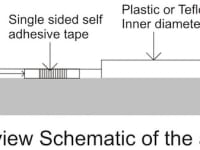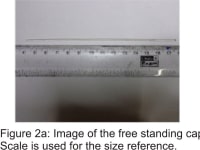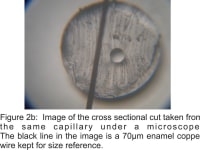Free standing flexible capillary made from silicone elastomer for medical and soft robotic applications.
Free standing flexible capillary was fabricated using 3 steps molding and demolding techniques.
Step 1:- On a rigid and sturdy base a plastic or Teflon tubing was placed horizontally and firmly attached to the base using self adhesive tapes. The length of the tubing decides the length of the capillary.
An organic/inorganic fiber is inserted which has length greater than the length of the tubing. Using two small supports fixed at two ends of the tubing, the fiber is placed and fixed on these supports by using self adhesive tape on the base as shown in the figure 1. This way the fiber is placed exactly co-axially with respect to the tubing. The diameter of the fiber decides the inner diameter of the capillary to be formed.
Step 2:- Dow Corning’s Sylgard 184® elastomer was used to make the highly flexible free standing circular capillary. The elastomer comprise of base and curing agent. They were taken in the ratio of 10:1 for base and curing agent respectively. They were thoroughly mixed and then kept in open air to degas for 30 minute. The mixer was taken into a 10ml syringe fitted with pipette tip. The mixer was then transferred from syringe and into the tubing from either of its openings. The tubing was filled completely. The mold was then kept at 60 degree in an oven to cure the elastomer for 3 hour.
Step 3:- After the curing process completes, two sub processes had been developed for taking out the final capillary from the mold.
(a) Cutting the tubing: - The plastic/Teflon® tubing was cautiously cut from one end of the tubing upto other end. As it became opened, the cured elastomer alongwith the fiber was taken out. The assembly was then dipped in ethanol to release the fiber from the elastomer thus forming the free standing capillary.
(b) Pretreatment of tubing using lubricant: - Before pouring the elastomer into the tubing, tubing was lubricated using oil. It was simply flown through the tube. After this the elastomer was filed inside the tubing and kept for curing. Following the curing procedure, the dipping of entire assembly into ethanol releases elastomer as well as the capillary.
This process of releasing does not yield any wastage of materials. The tubing and the fiber can be reused for numerous cycles of fabrication. Figure 2a and 2b shows the images of the free standing capillary and its cross sectional cut.
Applications :- Biomedical - Artificial Arteries/Veins
Soft Robotics – Polymer based robotic systems for handling fragile and sensitive materials.
Optics - Use as a waveguide
Energy - Waste Thermal energy generation and management from water at 100 degree celcius.
Video
Like this entry?
-
About the Entrant
- Name:Amit Morarka
- Type of entry:teamTeam members:Ketan Kanojia
- Patent status:pending








